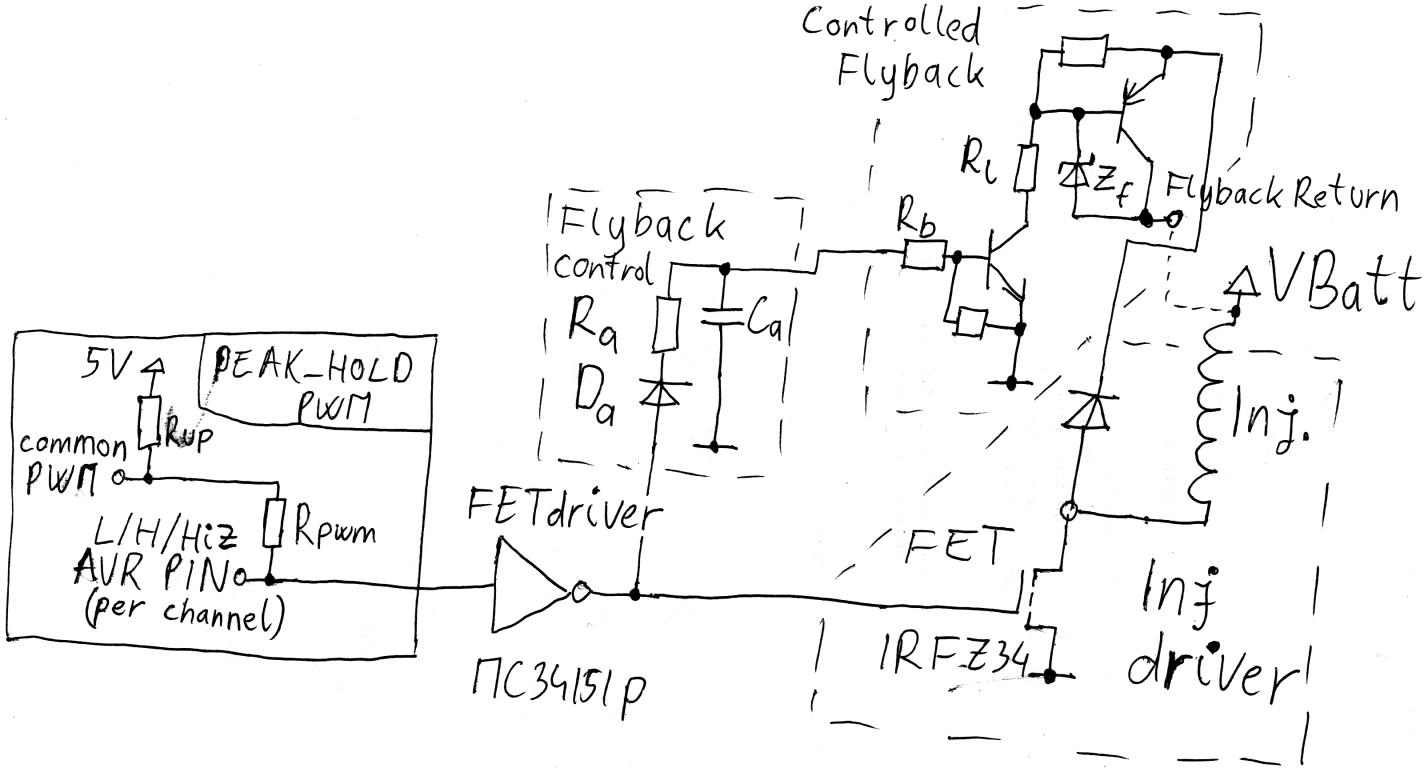See the FlyBack page for useful flyback related information.
This page is only for historical reasons, for the curious.
The flyback design went through a relatively winding road because the widely used motorola MegaSquirt had imprecise fuel calculations and people tried all kinds of workaround hacks to cancel the shortcomings.
The workaround often raised new problems, that had to be solved with more HW complexity.
The road was determined by:
- imprecise fuel calculations =>
- => high voltage FlyBack to make the injector closing less depend on VBatt
- => the PWM-ing (which is common for lowZ injectors) with high voltage (virtual zener-type) FlyBack. Because of the crazy heat this setup dissipates in the ECM (8..15 times more than the ECM should dissipate!)
- => special controlled FlyBack solutions were developed including microcontroller assisted (software configurable as on GenBoard/VerTwo) and standalone (hardware configurable, like the motorola megasquirt flyback-addon-board)
Seeing all the fuss, people thought that the FlyBack hardware must be complex to be good, and it took quite a while to realize that with precise fuel calculations and injector pulsewidth the simple FlyBack solution works better than the complex FlyBack solution with the imprecise calcs.
The (literally searchable, but effectively not) email archives largely contributed to the confusion. Had we used a wiki at that time instead of the mailing lists (and traditional forums) it would have been much easier to summarize the information and make an appropriate overview of the situation.
Forgive that the history below is not formatted, the main reason for the junk layeout is that it came from emails.
multichannel LOW-Z injector driving
MembersPage/KeithHargrove suggested a very smart, pin-efficient, no gates, no diode method for making PWM-ed signals for multichannel (up to 8) LOW-Z sequential injection:
[  See the Peak_Hold part on the schematic]
See the Peak_Hold part on the schematic]
The first part (uC pin and the FETdriver) is used on GenBoard/VerThree, actually 8 instances of it. The flyback control (delay-circuit) part and the controlled virtual-zener was only built as prototype, since it turned out that it's not needed.
Operation: one pin running PWM all the time feading each of the 8 injectors thru a resistor. And also each injector is connected to an output pin:
- output pin is low = injector on/peak (assuming inverting driver like MC34151p)
- output pin is hi = injector off
- output pin hi-Z = injector PWM
This way we only use one PWM pin. Only a little larger event-overhead than the analog-delayed peak-signal we had earlier (spoken from MembersPage/J├â┬ÂrgenKarlsson and MembersPage/MarcellGal). Personally I like it very much.
- Use 2 PWM-ing outputs with different phase (nice on the voltage-supply rail).
- Connect the PWM-ing outputs to 5V (or GND depending on inversion) via 20kOhm (inactivates injectors when avr-pins are hi-z).
- Connect the PWM-ing output to all the injcontrol outputs via 4..10kOhm.
- Connect the injcontrol outputs to the FETdriver input via 0..1kOhm.
- Connect the FETdriver outputs to FETs and with an asymetric DRC delay to the flyback control (base of NPN that drives the PNP).
This is very space and pin-efficient, especially with R-packs (not individual R-s). The flyback control is derived from the FET-gate signal (a little delayed compared to FET-gate): the DRC delay must be small
- so it activates the flyback before 15% * 64 usec (minimal active time)
- inactivate time must be above 85% * 64 usec so it does not deactivate for the thinnest PWM signal.
Note: we can declare the thinnest PWM signal be 18..20%, not 15%, those who want, can add some series resistors. (this is not more than a board-population / matching config issue anyway).
Note2: those having high-Z injectors probably want to leave out the controlled flyback. There is just no point in it (although it does not hurt either).
Also I am using a sn754410 (not MC34151p) it does not invert but digikey has it.
With many injector banks (like 8), one might consider to forget the controlled flyback and use a common flyback rail and only a diode per injector. A power-efficient (read: not that much heat) switching rail can be constructed:

discussion:
> I like the switching regulator.
> and I do not think it will take up much space
I think 1 might be enough on the board, maybe with a huge
PNP (bigger than TO-220 and on heatsink).
I think it is better to use 2 synced, but phase-offset PWM signals
(64usec period, OCR1B and OCR1C comes to mind) for the
lowZ injectors, so only 4 lowZ
injectors start flybacking at a time, the other 4 at
Marcell
another time. 4*3 A is not a small current in itself..
> can the oscillater stall if it get strange loads or low load.
> I think of any latch-up problems it might have..
I think it should not. A small resistor in series with Z14
might be a good idea (even Z14's internal dU/dI > 0), because
it allows more tolerance for the value of Rf
(note: the NPN changes its h21 with temperature, etc...)
C should be connected to VBatt (not GND, as on the picture),
and be at least 25V, 100uF (rather 220uF, we don't want too high
switching frequency).
> also I think the the box will have more 12V comming out then comming in.
> with all the current from the injectors. We should have the flyback/diodes
> tied to vbatt before any protection diodes
very good point!
I don't like those diodes very much, they don't protect the whole
circuit anyway. I like to short them with 1 Ohm, so I can measure
supply current easily.
I don't apply negative power, I use other ways of releasing the
smoke that was packaged into the chips and wires in the factory :-)
end of unformatted junk (provided only for historical reasons for the future EFI-archeologists)
See FlyBack